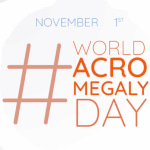World Acromegaly Awareness Day Date in the current year: November 1, 2025
 World Acromegaly Awareness Day, also known as World Acromegaly Day, is observed annually on November 1. It was created to educate the public about acromegaly, a disorder characterized by excessive growth of certain parts of the body.
World Acromegaly Awareness Day, also known as World Acromegaly Day, is observed annually on November 1. It was created to educate the public about acromegaly, a disorder characterized by excessive growth of certain parts of the body.Growth, cell reproduction, and tissue regeneration in the human body are regulated by the growth hormone produced by the pituitary gland. High levels of this hormone in adulthood can lead to acromegaly, an endocrine disorder involving abnormal growth of soft tissues and bones. Its characteristic features include enlarged hands, feet, and facial bones, as well as thickened skin and swelling of the soft tissues of internal organs.
The vast majority of acromegaly cases are caused by a benign pituitary tumor called a pituitary adenoma. This tumor produces excessive growth hormone, resulting in elevated growth hormone levels. The severity of acromegaly symptoms depends on the tumor’s size and growth rate.
In a small percentage of cases, acromegaly is caused by tumors in other organs, such as the lungs, pancreas, and adrenal glands. Rather than producing excess growth hormone, these tumors typically produce growth hormone-releasing hormone, which stimulates the pituitary gland to produce more growth hormone.
As mentioned above, the characteristic signs of acromegaly include enlargement of the hands, feet, facial bones, and internal organs, as well as skin thickening. Over time, these changes can lead to various complications. These include bone and joint problems (e.g., carpal tunnel syndrome, osteoarthritis, and joint pain), high blood pressure, cardiomyopathy, diabetes mellitus, sleep apnea, thyroid nodules or thyroid cancer, and colorectal cancer.
Additionally, a growing pituitary adenoma can compress surrounding brain tissues and the optic nerve. This can result in headaches, vision problems, and an impact on the production of sex hormones, leading to hypogonadism.
The preferred treatment for acromegaly is surgery to remove the adenoma. The smaller the tumor, the higher the chance of success. Even when surgery is successful, patients need long-term monitoring because the tumor might recur.
If surgery is not recommended, medications are prescribed to control growth hormone production. These medications include somatostatin (growth hormone-inhibiting hormone) analogs, dopamine antagonists, and growth hormone receptor antagonists. Radiation therapy may be used when neither surgery nor medication is fully effective in addressing symptoms and complications.
World Acromegaly Awareness Day was created to raise awareness of this rare endocrine disease and help people with acromegaly get timely diagnoses and access to treatment. You can get involved by learning more about the disorder and sharing what you’ve learned with others, donating to an organization that supports patients with acromegaly or funds research, and spreading the word on social media using the hashtags #WorldAcromegalyAwarenessDay, #AcromegalyAwarenessDay, and #WorldAcromegalyDay.
- Category
- International Observances
- Tags
- World Acromegaly Awareness Day, World Acromegaly Day, international observances, rare diseases, awareness days